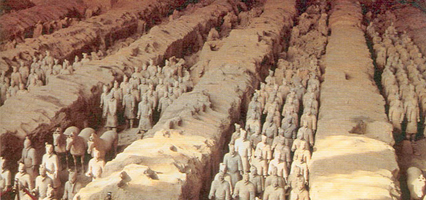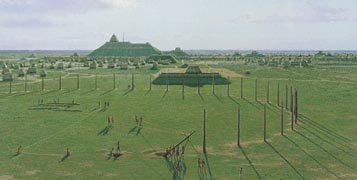Overview
This course discusses the basic philosophy and methods of archaeology, and provides an introductory survey of archaeological excavations and discoveries in the Near East, Africa, Asia, Europe, and the Americas, with an emphasis on understanding how change happened in the unwritten periods of human history. Beginning nearly four million years ago, topics include technologies and arts of hunting and gathering, rise of cities in Sumeria, early populations of the Americas, Maya, Aztec, and Inca, empires and symbolic sacrifice in Asia, tombs and pyramids of Egypt, Stonehenge and the megaliths of Europe, among others.
This course is planned for non-Anthropology majors, and is meant to appeal to students who have always had an interest in archaeology and the past. The course is primarily a survey of archaeological finds around the world. There will be two quizzes and two one-hour exams.
This course fulfills the Humanities -- History and Philosophy requirement within the General Education curriculum.
I have created a course web page for World Archaeology using the University's new Compass program. You can access the course web page by logging onto the Compass system, which will display all existing web pages for your courses. Choose Anth. 105 from the display list and you can access the course syllabus, assignments, lecture notes and illustrations, and other online class resources for World Archaeology. The logon page for Compass is available at:
https://compass2g.illinois.edu/webapps/login/ .
Course Requirements and PoliciesGrades, Exams and Assignments
When taking exams and quizzes, you will be responsible for knowing the concepts and terms discussed in the assigned readings, in the films shown in class, and in the topics covered in lectures, handouts, and web page or power point summaries. No make-ups are provided for missed exams, quizzes, or assignments in the absence of documented and legitimate medical or family emergencies. Your regular attendance and active participation are of central importance for this course to provide you with both a fun and satisfying educational experience. Good attendance, class preparation, and note-taking practices will be very important for your ability to perform well. I reserve the right to lower the course grade (by one letter grade) of any student who fails to regularly attend class during the semester.
Your grade will be based on your performance on quizzes and exams:
| Graded Component | % of Course Grade | Schedule |
| Quiz 1 | 20 | Sept. 27 |
| Midterm Examination | 30 | Oct. 23 |
| Quiz 2 | 20 | Nov. 15 |
| Final Examination | 30 | Dec. 11 |
You can also obtain extra credit by attending a talk or museum exhibit related to archaeology and submitting a two-page essay on the subject in accordance with the related guidelines.

Required Text
 Images of the Past, by T. Douglas Price & Gary M. Feinman (7th ed., 2012, McGraw-Hill). Images of the Past, by T. Douglas Price & Gary M. Feinman (7th ed., 2012, McGraw-Hill).
The text listed above is available at the University bookstores and can also be obtained from other vendors of your choosing. The 6th edition (2009), which can be obtained "used" for low prices by mail order, will also suffice. I will also place copies of past editions of this text on reserve at the Undergraduate Library.
This syllabus lists chapters and page ranges as listed in the 7th edition of the "Images of the Past" text. You can see the associated headings for those chapters and page ranges in the detailed Table of Contents from the 7th edition to find the same subject-matter discussion in a different edition of the book (be it print or digital).
 Other suggested (not required) readings and resources that provide additional information related to the subjects will be available online in the course web page I have created using the University's Compass program. Other suggested (not required) readings and resources that provide additional information related to the subjects will be available online in the course web page I have created using the University's Compass program.

Class Meeting Times and Locations:
The class meets on Mondays, Wednesdays, and Fridays, 9:00am to 9:50am in Room 156 of the Henry Administration Building. Course Instructor: Chris Fennell, office in 296 Davenport Hall, cell phone (312) 513-2683; email cfennell@illinois.edu; office hours on Mondays and Wednesdays, 1:30pm to 3:00pm. Teaching Assistant: Rachel Gill, office in 309Q Davenport Hall; email rgill5@illinois.edu; office hours Fridays, 10:00am to 1:00pm.
Class Schedule and Readings:
Week 1. Overview of Course & Introduction to Methods of Investigating the Past
Aug. 26, 28 & 31: Images, Chapter 1, pp. 1-33 (Principles of Archaeology); Images, pp. 48-49 (dating methods), 137-38 (radiocarbon dating), 329-30 (settlement pattern surveys).
Labor Day break! Sept. 2. |
Week 2. Archaeology Methods: Space, Time and Context
Sept. 4 & 6: Week 1 readings cont'd. |
Week 3. A Brief History of the Universe and the Evolution of Humans
Sept. 9, 11 & 13: Images, Chapter 2 (The First Humans), pp. 35-47, 50-96. |
Week 4. Hunting, Gathering, the Paleolithic, and Migrations to the Americas
Sept. 16, 18 & 20: Images, Chapter 3, pp. 99-136, 139-76. Film: Cave of Forgotten Dreams, by Werner Herzog (2011), an exploration of art in Chauvet cave dating to 30,000 BP.
| Week 5. Developments in Sedentism and Domestication
Sept. 23, 25 & 27: Images, Chapter 4. Quiz 1: in class, Sept. 27. |
Week 6. A Diversity of Lifeways in Prehistoric North America
Sept. 30, Oct. 2 & 4: Images, Chapter 5. Suggested reading: "Mass Inhumation and the Execution of Witches in the American Southwest," by J. A. Darling, American Anthropologist 100(3): 732-752 (1999). Film: Myths and the Moundbuilders (1995, PBS Odyssey Series), exploring monumental architecture in prehistoric North America and impact of racism on interpretations of such past, cultural remains.
 |
Week 7. Ancient Mesoamerica: the Olmec, Monte Alban and Teotihuacan
Oct. 7, 9 & 11: Images, Chapter 6, pp. 303-37. |
Week 8. Ancient Mesoamerica: the Maya and Aztecs
Oct. 14, 16 & 18: Images, Chapter 6, pp. 338-70. |
Week 9. South America, the Inca and Predecessors, Moche, and Nazca
Oct. 21, 23 & 25: Images, Chapter 7.Midterm Exam: in class, Oct. 23. |
Week 10. States and Empires of Asia: Eridu, Uruk, Harappa, Shang, and Xianyang
Oct. 28, 30 & Nov. 1: Images, Chapter 8, pp. 419-43, 457-77. |
Week 11. States and Empires of Africa: Egypt, Great Zimbabwe,
Kingdom of Kongo and its Diasporas
Nov. 4, 6 & 8: Images, Chapter 8, pp. 444-56, 474-87. Online resource: the Archaeological Institute of America is presenting an online, interactive dig tracking the ongoing excavations at Hierakonpolis (discussed in pp. 444-48 in this week's readings), available at:
http://www.archaeology.org/interactive/hierakonpolis/index.html.
|
Week 12. Prehistoric Europe: Hunters, Farmers, and Empires
Nov. 11, 13 & 15: Images, Chapter 9. Quiz 2: in class, Nov. 15. |
Week 13. Learning from the Past: Archaeology Insights and Applications
Nov. 18, 20 & 22: Images, Chapter 10.
Thanksgiving break! Nov. 23 to Dec. 1. |
Week 14. Learning from the Past: Ethics and Heritage
Dec. 2, 4 & 6: Images, Chapter 10. Film: Who Owns the Past? |
Concluding Remarks and Review
Dec. 9: come to class with questions in mind for our final review. |
| Final Exam. Our second and final exam will be held in class on Wednesday, Dec. 11, 9am to 9:50am. |
Additional internet resources on anthropology and archaeology, which are suggested only and not required reading for this course, are available at:
http://faculty.las.illinois.edu/cfennell/bookmark2.html
Additional internet resources on African and African-American archaeology, cultures, and history, which are suggested only and not required reading for this course, are available at:
http://www.diaspora.illinois.edu/bookmark3.html

Last updated: October 13, 2019
|

